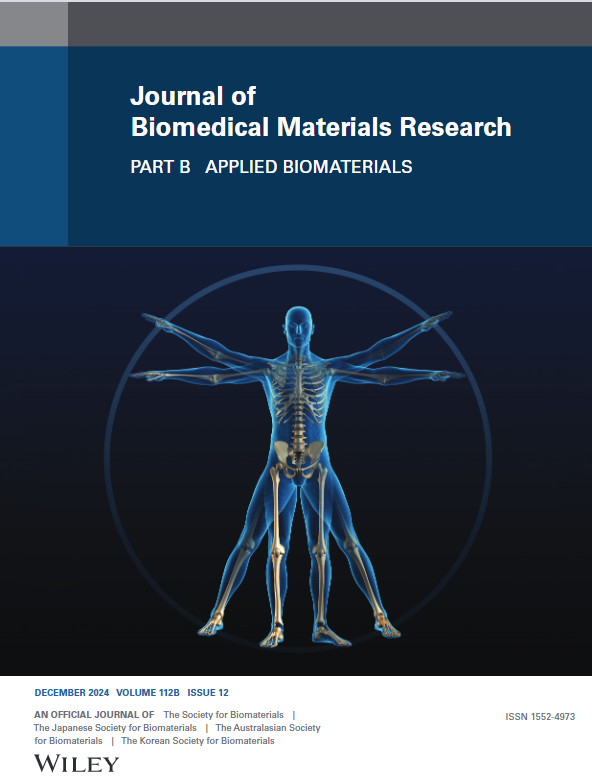应用 3D 打印技术创建体外动脉瘤破裂模型。
摘要
目前可用的台式(体外)动脉瘤模型不足以测试血管内设备治疗的效果。具体来说,目前的模型不能代表巨大动脉瘤(定义为高度或宽度为 25 毫米的动脉瘤)的机械不稳定性,也不能在模拟生理条件下预测破裂。因此,需要具有生物力学相关材料特性和可预测破裂时限的体外动脉瘤模型,以准确评估新医疗设备治疗方案的疗效。了解动脉瘤临近破裂时的材料特性(如剪切模量和压缩模量)是创建病理相关的复杂体外动脉瘤破裂模型的关键一步。我们通过酶处理研究了血管材料特性的变化,以模拟动脉瘤壁的降解,并利用这些信息,使用最新的增材制造技术(3D 打印)和类组织材料创建了复杂的动脉瘤破裂模型。在用胶原酶 D 酶孵育(37°C 30 分钟)前后,对猪颈动脉血管的机械性能(剪切模量和压缩模量)进行了评估,以模拟生化活动对动脉瘤壁接近破裂的影响,并与对照血管(未处理)进行比较。为了与这些动脉血管进行比较,测试了一种柔软而有弹性的 3D 打印材料(VCA-A30:硬度为 30 shore A)的机械强度。然后用这种材料制作球形、巨型(直径 25 毫米)动脉瘤模型,并在神经血管压力(120/80 ± 5 mmHg)、每分钟心跳(BPM = 70)和代表大脑中动脉[MCA:142.67 (±20.13) mL/min]的流量下运行,使用具有非牛顿剪切稀化特性的血液模拟物[3.6 (±0.4) cP 粘度]。处理前猪颈动脉血管的剪切模量为 12.2 (±2.7) KPa,压缩模量为 663.5 (±111.6) KPa。经胶原酶 D 酶解处理后,动物组织的剪切模量降低了 33%(p 值 = .039),而压缩模量在统计上保持不变(p 值 = .615)。对照组(未经处理的血管)的剪切模量降低幅度很小(13%,p 值 = .226),而压缩模量增加了 78% (p 值 = .034)。三维打印材料的剪切模量为 228.59 (±24.82) KPa,压缩模量为 668.90 (±13.16) KPa。这种材料被用来制作复杂的体外巨大动脉瘤破裂模型原型。在生理压力和流速的作用下,未经处理的模型在约 12 分钟后破裂。这些结果表明,利用最新的三维打印材料,连接到生理相关的可编程泵,可以在台式体外模型中稳定地再现动脉瘤破裂。进一步的研究将调查动脉瘤内各种动脉瘤穹顶厚度区域的优化情况,并根据动脉瘤模型内压力和流量变化的可测量效应,调整破裂时间,以比较动脉瘤装置的部署和台式控制。这些优化的体外破裂模型可通过量化特定的装置破裂时间和动脉瘤破裂位置,最终用于测试装置治疗方案的疗效和破裂风险。Currently available benchtop (in vitro) aneurysm models are inadequate for testing the efficacy of endovascular device treatments. Specifically, current models do not represent the mechanical instability of giant aneurysms (defined as aneurysms with 25 mm in height or width) and do not predictably rupture under simulated physiological conditions. Hence, in vitro aneurysm models with biomechanically relevant material properties and a predictable rupture timeframe are needed to accurately assess the efficacy of new medical device treatment options. Understanding the material properties of an aneurysm (e.g., shear and compression modulus) as it approaches rupture is a crucial step toward creating a pathologically relevant and sophisticated in vitro aneurysm rupture model. We investigated the change in material properties of a blood vessel, via enzymatic treatment, to simulate the degradation of an aneurysm wall and used this information to create a sophisticated aneurysm rupture model using the latest in additive manufacturing technologies (3D printing) with tissue-like materials. Mechanical properties (shear and compression modulus) of swine carotid vessels were evaluated before and after incubation with collagenase D enzyme (30 min at 37°C) to simulate the effect of biochemical activity on aneurysm wall approaching rupture compared to control vessels (untreated). Mechanical strength of a soft and flexible 3D-printed material (VCA-A30: 30 shore A hardness) was tested for comparison to these arterial vessels. This material was then used to create spherical shaped, giant-sized (25-mm diameter) aneurysm phantoms and were run under neurovascular pressures (120/80 ± 5 mmHg), beats per minute (BPM = 70) and flows representing the middle cerebral artery [MCA: 142.67 (±20.13) mL/min] using a blood analog [3.6 (±0.4) cP viscosity] with non-Newtonian shear-thinning properties. The shear modulus of swine carotid vessel before treatment was 12.2 (±2.7) KPa and compression modulus was 663.5 (±111.6) KPa. After enzymatic treatment by collagenase D, shear modulus of animal tissues reduced by 33% (p-value = .039) while compression modulus remained statistically unchanged (p-value = .615). Control group (untreated vessels) showed minimal reduction (13%, p-value = .226) in shear modulus and 78% increase (p-value = .034) in compression modulus. The shear modulus of the 3D-printed material was 228.59 (±24.82) KPa while its compression modulus was 668.90 (±13.16) KPa. This material was used to prototype a sophisticated in vitro giant aneurysm rupture model. When subjected to physiological pressures and flow rates, the untreated models consistently ruptured at ~12 min. These results indicate that aneurysm rupture can be recreated consistently in a benchtop in vitro model, utilizing the latest 3D-printed materials, connected to a physiologically relevant programmable pump. Further studies will investigate the optimization of various aneurysm dome thickness regions within the aneurysm, with tunable rupture times for comparison of aneurysm device deployment and benchtop controls based on the measurable effects of pressure and flow changes within the aneurysm models. These optimized in vitro rupture models could ultimately be used to test the efficacy of device treatment options and rupture risk by quantifying specific device rupture times and aneurysm rupture position.

 求助内容:
求助内容: 应助结果提醒方式:
应助结果提醒方式:


